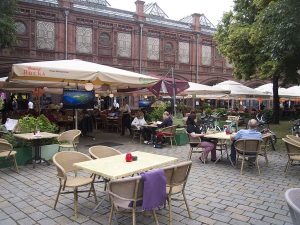
We finally had a lovely day all day. After breakfast outdoors in the Hackescher Markt, we took the train (the underground U-Bahn this time) to Checkpoint Charlie to see what it looked like. No big deal. Three men dressed like American soldiers (NOT) were collecting money, one pound per person, from tourists to pose with them for selfies.
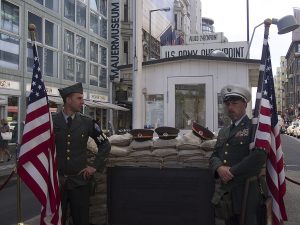
Next we went back to the Nordbahnhof station to see what we missed on Tuesday at the Berlin Wall Museum. First were the descriptions of the “ghost stations”—inside the station itself—of the train stations that had to be blocked up and put out of service at the borders to prevent the citizens of East Berlin escaping to the West. Horrible the lengths the East German government went through to prevent ordinary citizens from leaving their repressive regime.
Then we went to the small Reconciliation Chapel that replaces and commemorates the Reconciliation Church that the SED (the government of East Berlin) blew up in 1985 because it was inside the border zone and a constant reminder to everyone with its high steeple and graveyard between the two walls.
Finally, we went to the Visitors Center to view two short films—one about the history of the wall and the other an animation of what the border defenses looked like.
After leaving the Berlin Wall Memorial, we discovered the Museum für Naturkunde (Natural History Museum) and spent about an hour going through their fascinating displays. They have the largest complete dinosaur skeleton in the world and a T Rex (which they have named Tristan) uncovered in Montana. An hour barely scratched the surface, but we were glad we went.
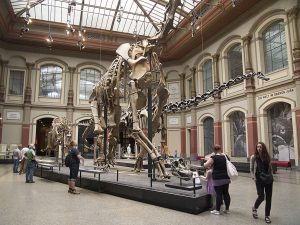
Next, we took our first tram ride (completing the list of kinds of public transportation in Berlin) and another S-Bahn train to visit the Siegessäule again, so we could climb it this time. We got off the train at Bellevue and strolled through the Tiergarten park and past the Bismark monument to reach the tower in the center of the Großer Stern (Great Star), the rotary around the monument.
Tunnels under the roadway allow you to get past the incredibly busy traffic at the base. We climbed to the first level and stopped to view the impressive Prussian mosaics that encircle the base at close range.

Then we climbed the rest of the circular staircase to the top. The entire monument is about 66 meters high (or about 220 feet). At the top, you can walk all around, viewing the city and the streets approaching like spokes of a wheel (very similar to the Arc de Triomphe in Paris). You can also look up and see the skirts of the winged angel overhead.
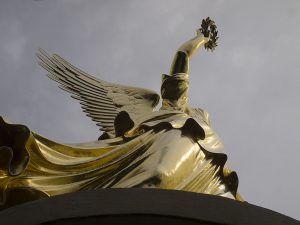
After taking the bus back towards our hotel, we visited the Nikolai Viertel, or Nicholas Quarter, which contains some of the oldest houses in Berlin. In between, there is a construction zone for a new branch of the U-Bahn. In fact, the entire city is under construction. You can’t go three feet without finding a building wrapped in gauze or plastic or scaffolding. There are barricades and fences and cranes everywhere you look. Prosperity brings money to spend.
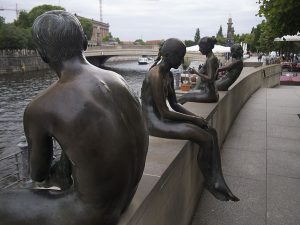
For dinner, we walked to the Hackesche Höfe and ate at the Hackescher Hof restaurant that shares the tiny courtyard with the Oxymoron restaurant where we dined the first night.
After dinner, it being a fine night, we walked back to the Spree, past all the fans in lawn chairs rooting in every outdoor restaurant for the German-Poland soccer (football) match on the flat-screen TVs everywhere. The collective cheers and groans echoed in unison from every establishment. (The game still ended 0-0.) Fußball is very big here in Europe, especially now in the lead-up to the Euro Cup on July 10th.
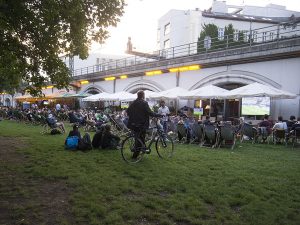
To end our time in Berlin, we strolled along the Spree towards our home base opposite the Berliner Dom, enjoying the lovely evening air as long as possible before retiring to our hotel room.
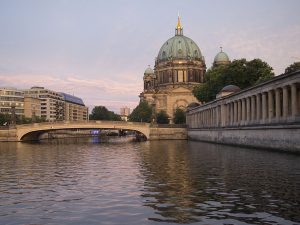
Photographs © 2016 P.J. Gardner. All rights reserved.